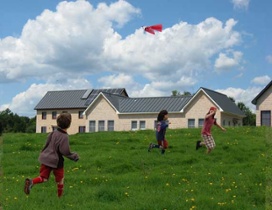
Cost Savings of Living in a Passive House
8/30/2014
Some of the most energy-efficient homes on US soil, Belfast Ecovillage homes use 90 percent less energy to heat and cool.
While typical homes of a comparable size require families to spend several thousand dollars each year on heat alone, my family of four in Midcoast Maine spent less than $120 a month last winter on all our utilities, including heat and hot water. On cold, windy days, our home has no drafts. During sunny winter days, our home is heated exclusively by solar gains, and the heating system doesn’t turn on for many hours. Despite having no air conditioning, our home is comfortable throughout the summer. The secret is that we live in a home at Belfast Cohousing & Ecovillage that was constructed to the Passive House standard (although it was not certified).
Homes built to the Passive House standard use a mere 10 percent of the energy for heating and cooling that a code-built home does. For every $1 our neighbors pay to heat their homes, we pay only 10 cents. Generous quantities of insulation in the foundation, walls, and roof; a solar orientation; exceptional ventilation; triple-pane windows and doors; an airtight envelope; lots of southern glazing; and thermal mass in the slab have resulted in exceptional comfort and very low utility bills.
The super energy efficiency of our home begins in the foundation, with a layer of rigid foam between the cement slab and the ground. The slab stores solar heat during winter days and slowly releases it into the home at night (when the ambient temperature is lower). The walls are constructed with a layer of SIPs (structural insulated panels), which contain a foam core, resulting in a continuous insulation that prevents heat from leaking out. Blown-in cellulose is added to the walls and ceiling, and we have a standing seam metal roof, a durable and energy-efficient alternative to roof shingles.
Such a home would not have healthy indoor air if it weren’t for our Zehnder heat recovery ventilation (HRV) system. In our house, stale air is removed from the kitchen and bathroom, with fresh air supplied to the bedrooms. This prevents moisture issues and boosts air quality without compromising efficiency. At the same time, heat is transferred from the outgoing air to the incoming air, preventing heat loss. Zehnder’s HRV systems are up to 95 percent efficient.
As a result, our home does not have bathroom exhaust fans or a vented hood over the range because these would vent warm air out of the house without capturing the heat. If we wish to remove odors, fumes, smoke from cooking, or condensation after showering, we can temporarily boost the HRV system.
Triple-pane Unilux windows and doors complement the HRV system and the super insulation. Even with subzero temperatures on windy nights, I felt no drafts when sitting in front of the windows, partly because of the airtight seal. The windows can swing inward on two hinges or tilt inward to open at the top. The latter offers draft-free ventilation, prevents rain from entering the home, and is safe for children.
Passive House builders go to great lengths to air-seal the homes, caulking and taping the SIPs together and applying house wrap to the exterior. The result is a virtually airtight home. A blower door test was performed on all Belfast Cohousing & Ecovillage homes, with all of them showing below 0.6 air exchanges per hour at 50 Pascal pressure, as specified in the Passive House standard. This is a measure of how many air changes take place in the house in one hour, so a lower number indicates that a home is more sealed to the outside. Because our home is virtually airtight, an HRV system is necessary to ensure high-quality air and avoid moisture problems in our cold climate.
The southern glazing on the home allows the heat of the sun to gradually warm our home. We are diligent to not block the winter sun with curtains or foliage. If we set our thermostat to 65°F, the home will often reach the upper 70s on a sunny day without the heating system turning on. The southern windows also bring lots of natural light into our home, helping to prevent winter doldrums and providing scenic views.
When the home heats up, warmth is stored in the cement slab. When the indoor temperature starts to drop, the heat from the slab is slowly released, helping to stabilize the temperature. On many sunny winter days, our heating system didn’t turn on until well into the night.
During a five-day power outage last December, we had a chance to really see how our home would perform. Would we need to stay with friends or in a hotel until it passed? Despite below-freezing temperatures and mostly overcast weather throughout, our home lost only 2 degrees a day. When my husband and kids would do jumping jacks, they could warm a room by a couple of degrees.
